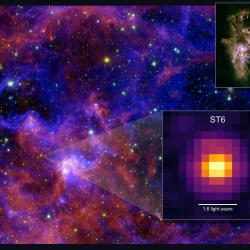Spinning Comet Slows Down During Close Approach to Earth
Astronomers observe the most drastic slowing of a comet's rate of spin ever measured
A team of astronomers from the University of Maryland, Lowell Observatory and the University of Sheffield has observed the most drastic slowing of a comet's rate of spin ever measured.
Using the Discovery Channel, Hall and Robotic Telescopes operated by Lowell near Flagstaff, Arizona, the researchers determined that the comet more than doubled its rotational period, or the time it takes to spin around once on its axis, within six weeks’ time.
The comet, named 41P/Tuttle-Giacobini-Kresak, increased its rotational period from 24 hours to more than 48 hours over the course of the observations. According to the researchers, if the comet continues to slow down, it could stop completely and begin rotating in the opposite direction.
The team included Matthew Knight, an assistant research scientist in the UMD Department of Astronomy, and was led by Lowell astronomer and UMD alumnus Dave Schleicher (M.S. ’80, Ph.D. ’83, astronomy). The researchers presented their preliminary results at a press conference on October 18, 2017, at the 49th Meeting of the American Astronomical Society Division for Planetary Sciences in Provo, Utah.
With a small and relatively inactive nucleus—the solid ball of dust and ice at the center of the comet—41P/Tuttle-Giacobini-Kresak had proven difficult for astronomers to study in detail. That all changed in early 2017, when the comet passed within 13 million miles from Earth—the closest since its discovery.
As a comet gets closer to the sun and the ice on its surface vaporizes, the comet develops jets of gas and dust. One of the most common gases found in comets is cyanogen, which is composed of one carbon atom and one nitrogen atom.
The team found and measured the motion of two cyanogen jets shooting from the surface of 41P/Tuttle-Giacobini-Kresak. From these jets, they determined that the rotation period increased from 24 hours in March to 48 hours in late April, slowing down to less than half the rotation speed by the end of the observing campaign in May.
“While we expected to observe cyanogen jets and be able to determine the rotation period, we did not anticipate detecting a change in the rotation period in such a short time interval,” Schleicher said. “It turned out to be the largest change in the rotational period ever measured—more than a factor of 10 greater than found in any other comet.”
The results suggest that the comet has an elongated shape, low density and jets located near the end of its body, according to the researchers. The jets provide the torque needed to slow the comet’s rotation.
“If future observations can accurately measure the dimensions of the nucleus, then the observed rotation period change would set limits on the comet’s density and internal strength,” Knight said. “Such detailed knowledge of a comet is usually only obtained by a dedicated spacecraft mission like the recently completed Rosetta mission to comet 67P/Churyumov-Gerasimenko.”
Comets are believed to be remnants from the formation of the solar system, having changed little during the past 4.5 billion years. Comet 41P/Tuttle-Giacobini-Kresak is known as a “short-period comet” because it completes an orbit around the sun every 5.4 years.
First discovered by Horace Tuttle in 1858, the comet was lost for years until it was rediscovered by Michel Giacobini in 1907. Lost again and rediscovered a third time in 1951 by Lubor Kresak, the comet now carries the names of all three independent discoverers.
###
This release was adapted from text provided by Lowell Observatory.
This research was supported by NASA’s Planetary Astronomy Program and the Marcus Cometary Research Fund. The content of this article does not necessarily reflect the views of these organizations.
Media Relations Contact:
Matthew Wright, 301-405-9267, mewright@umd.edu
University of Maryland
College of Computer, Mathematical, and Natural Sciences
2300 Symons Hall
College Park, MD 20742
www.cmns.umd.edu
@UMDscience
About the College of Computer, Mathematical, and Natural Sciences
The College of Computer, Mathematical, and Natural Sciences at the University of Maryland educates more than 7,000 future scientific leaders in its undergraduate and graduate programs each year. The college's 10 departments and more than a dozen interdisciplinary research centers foster scientific discovery with annual sponsored research funding exceeding $150 million.







